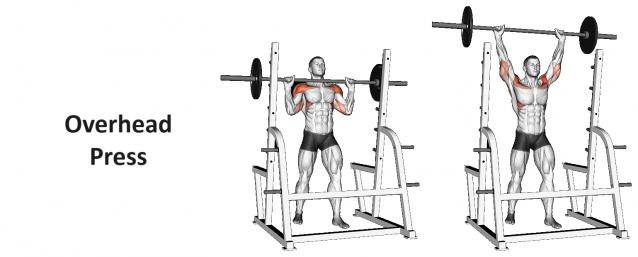The Overhead Press, also known as the Shoulder Press, is a classic strength training exercise that targets the deltoid muscles of the shoulders, along with the triceps and upper chest muscles. In this comprehensive guide, we’ll explore the correct technique, benefits, alternatives, and other essential details associated with the Overhead Press.
Instructions
Setup:
- Standing Position: Stand with your feet shoulder-width apart, knees slightly bent, and core engaged. Hold a barbell or pair of dumbbells at shoulder height with an overhand grip (palms facing forward).
- Hand Placement: Position your hands slightly wider than shoulder-width apart on the barbell, or hold the dumbbells at shoulder height with your palms facing forward.
Execution:
- Pressing Motion: Exhale as you press the weight overhead until your arms are fully extended, but not locked out. Keep your head neutral and maintain a slight backward lean to clear your head as the weight moves upwards.
- Controlled Lowering: Inhale as you slowly lower the weight back down to shoulder height, maintaining control over the movement. Avoid letting the weight crash down or using momentum to lift it.
- Repeat: Perform the desired number of repetitions with proper form and control.
Tips:
- Keep your core engaged and avoid overarching your lower back during the movement.
- Maintain a slight bend in your knees to help absorb the force generated by pressing the weight overhead.
- Keep your elbows slightly in front of your body to reduce stress on the shoulder joints.
Benefits
- Deltoid Development: The Overhead Press targets the deltoid muscles of the shoulders, helping to build strength and size in the front (anterior), middle (lateral), and rear (posterior) deltoids.
- Triceps Engagement: The triceps muscles are engaged as synergists during the pressing motion, assisting the shoulders in extending the arms overhead.
- Upper Chest Activation: Depending on the grip width and hand placement, the upper chest muscles (pectoralis major) may also be engaged to a lesser extent.
- Core Stability: Performing the Overhead Press requires core stability to maintain proper posture and balance throughout the movement, leading to improved core strength.
Muscles worked in Overhead Press
The Overhead Press primarily targets the deltoid muscles of the shoulders, engaging all three heads of the deltoids:
- Anterior Deltoid: The front portion of the deltoid muscle is heavily engaged during the pressing motion of the Overhead Press. It is responsible for shoulder flexion and horizontal adduction.
- Lateral Deltoid: The middle portion of the deltoid muscle is also significantly activated during the exercise. It is responsible for shoulder abduction, which occurs when lifting the arms away from the body to the sides.
- Posterior Deltoid: The rear portion of the deltoid muscle is engaged to a lesser extent during the Overhead Press. It is responsible for shoulder extension and horizontal abduction.
Additionally, the Overhead Press engages several other muscles as synergists and stabilizers, including:
- Triceps Brachii: The triceps muscles are engaged as synergists during the pressing motion, assisting the shoulders in extending the arms overhead.
- Upper Chest (Pectoralis Major): Depending on the grip width and hand placement, the upper chest muscles may also be engaged to a lesser extent to assist in the pressing motion.
- Trapezius: The middle and upper fibers of the trapezius muscle help stabilize the shoulders and support proper posture during the exercise.
- Serratus Anterior: The serratus anterior muscles, located on the sides of the rib cage, assist in stabilizing the shoulder blades and supporting arm movement.
Overall, the Overhead Press is an effective compound exercise for targeting the deltoid muscles of the shoulders while also engaging several other muscles of the upper body to provide stability and support during the movement.
Alternate names for Overhead Press:
- Shoulder Press
- Military Press
- Overhead Shoulder Press
- Barbell Press
Alternatives
- Dumbbell Shoulder Press: Perform shoulder presses using dumbbells instead of a barbell, allowing for a greater range of motion and unilateral training.
- Seated Shoulder Press: Sit on a bench or chair while performing shoulder presses to reduce lower back strain and focus solely on upper body strength.
- Push Press: Incorporate leg drive and momentum to press heavier weights overhead, allowing you to lift more weight than with a strict Overhead Press form.
- Kettlebell Press: Use kettlebells to perform overhead presses, which can provide a different challenge to the shoulders and stabilizing muscles.
Conclusion
The Overhead Press is a fundamental exercise for building strength and muscle mass in the shoulders, triceps, and upper chest. By mastering proper technique and incorporating variations and alternatives, you can effectively target and develop your upper body muscles while improving core stability and overall strength.

